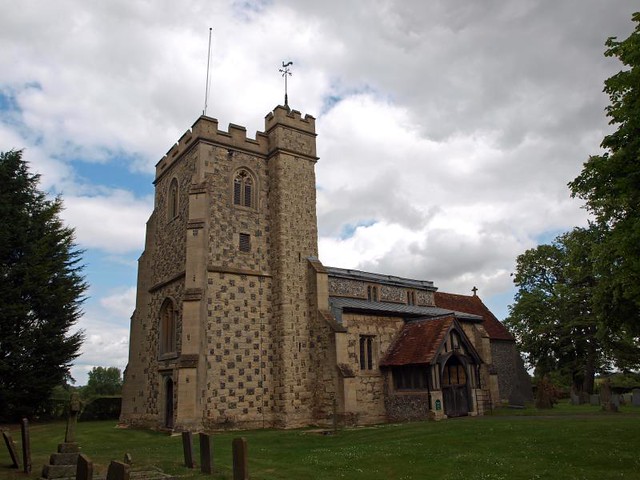ST MARY. A small church with a low W tower with NW stair-turret higher than the tower. The masonry is flint and stone in a chequer pattern. The S aisle is stone with occasional flint, the clerestory has only two windows each side. The chancel is lower than the nave. The interior of the nave has three bays with slim octagonal piers. The S arcade has double-chamfered arches, the N arcade double-convex chamfering and fine capitals. Both are C14. The clerestory and roof are C15. - Below the beams are standing figures of saints. - PULPIT with very rustic C17 carving. - PLATE. Chalice, 1569.
Puttenham. Hertfordshire’s Farthest West, it has a small gathering of houses and farms in peaceful meadows where the county points a finger into Buckinghamshire, with the Chiltern chalk hills not far away. The old work in the attractive little church of flint and stone comes from the 14th to the 16th century, but the chancel, the porch of stone and timber, and the top of the chequered medieval tower were made new last century. The tower has a turret rising above the battlements, and the porch shelters a Tudor doorway with a medieval door on its old hinges. The arcades and the chancel arch are 600 years old; the clerestory is 500. There are medieval oak benches, a few 15th-century tiles in the chancel floor, and an old priest’s desk. From the 17th century come the altar table, a plain cover to a font looking old enough to be Norman, and the quaint six-sided pulpit, its wide border carved with curious dragons or sea-serpents with curled tail. The chalice is Elizabethan.
The glory of the church is the almost flat 15th-century roof of the nave, its mass of moulded beams enriched with bosses of flowers and shields; one plays on the name Hutton, spelling the first syllable and picturing the last with a tun or cask. Angels are on the ends of the beams, and the roof rests on eight saints standing on the shoulders of quaint birds. The south aisle has a simpler roof with old beams.
The glory of the church is the almost flat 15th-century roof of the nave, its mass of moulded beams enriched with bosses of flowers and shields; one plays on the name Hutton, spelling the first syllable and picturing the last with a tun or cask. Angels are on the ends of the beams, and the roof rests on eight saints standing on the shoulders of quaint birds. The south aisle has a simpler roof with old beams.

No comments:
Post a Comment